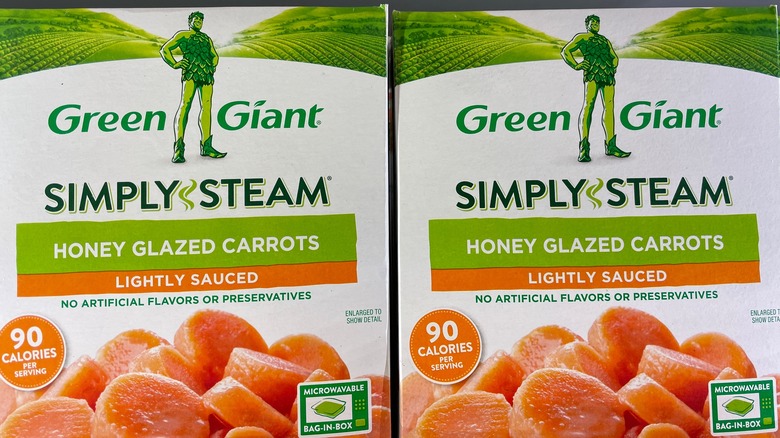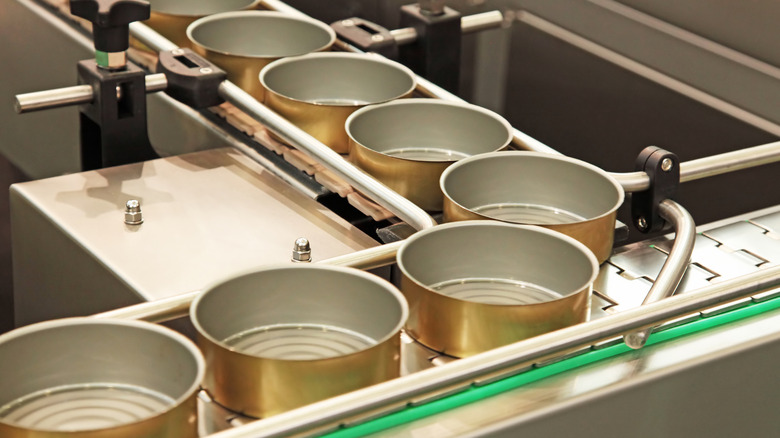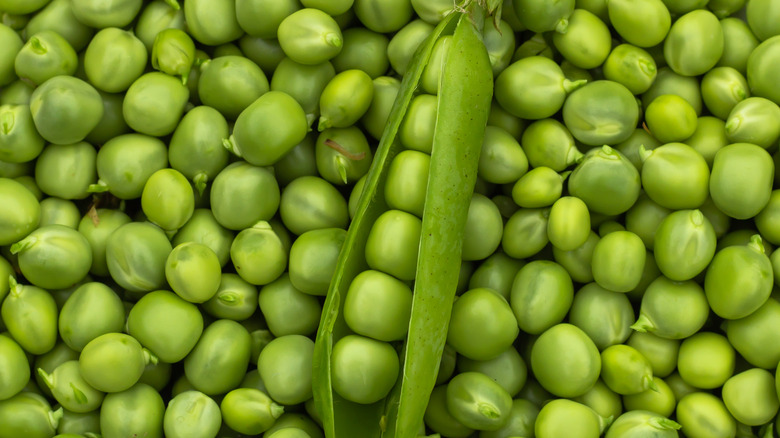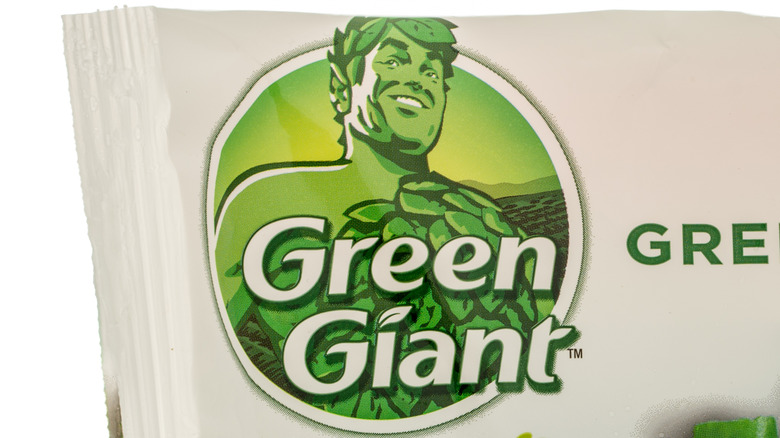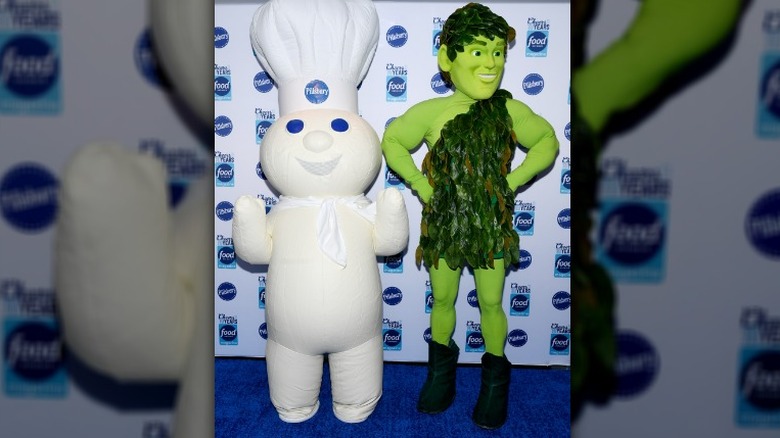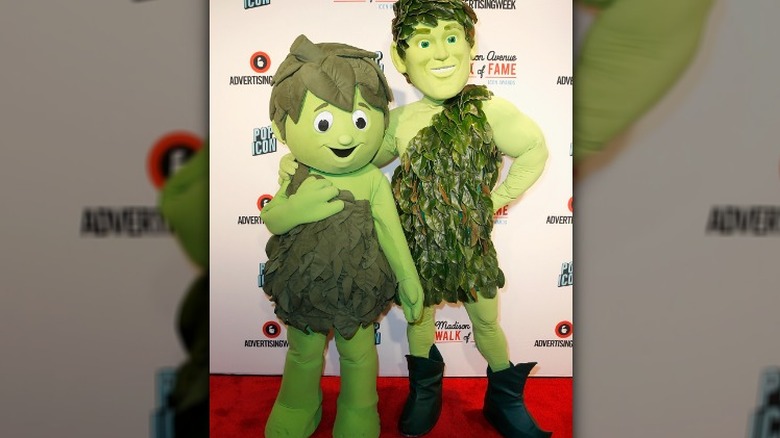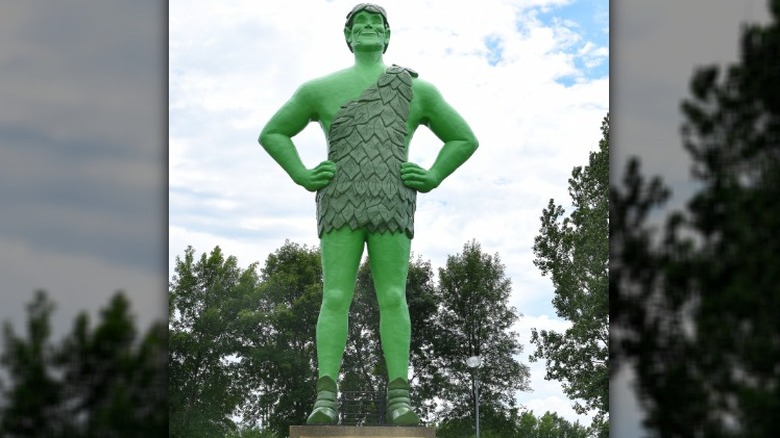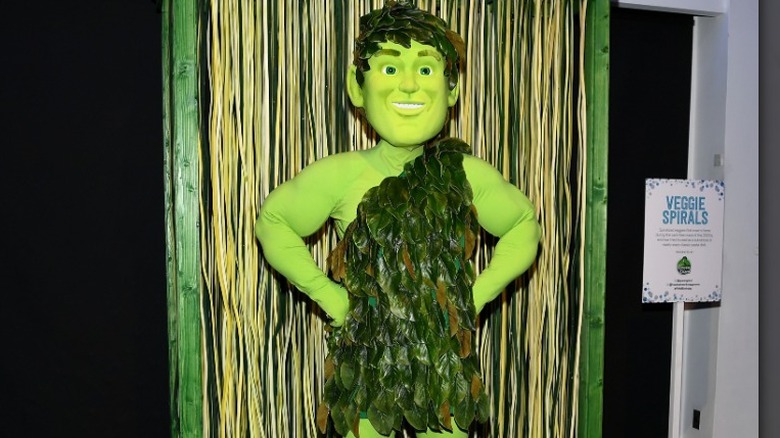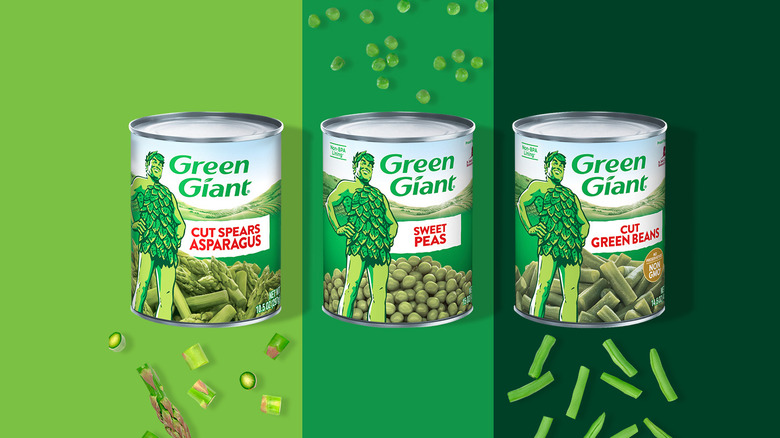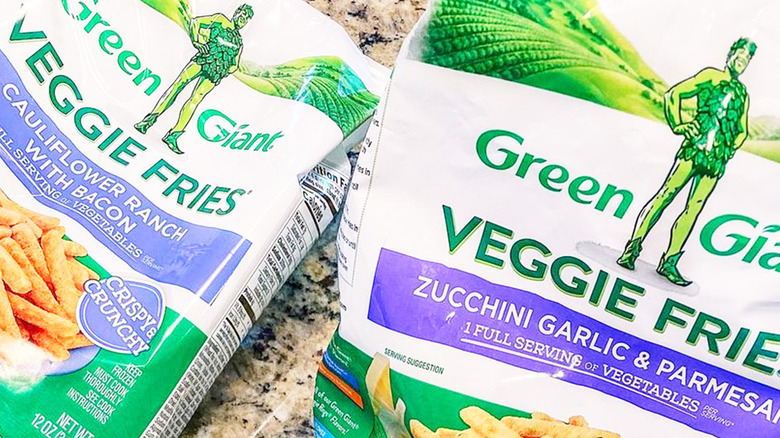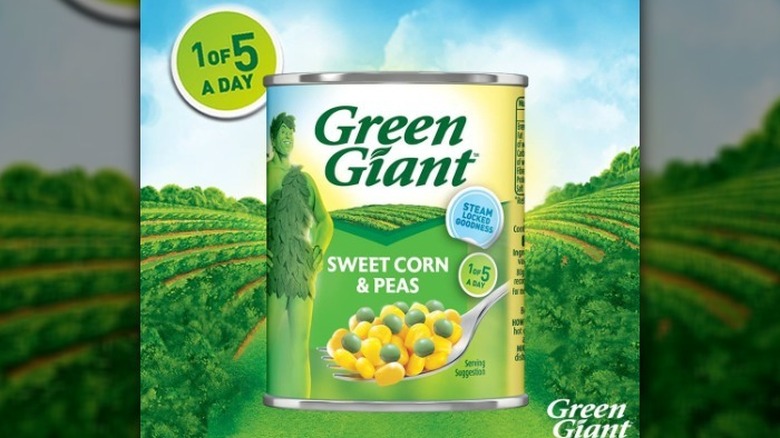Everything You Should Know About Green Giant Vegetables
The Jolly Green Giant and his parent company, Green Giant, have a more interesting backstory than you might think. The mascot is recognized worldwide as the symbol of the vegetable brand. He is deeply ingrained in pop culture, as well as in everyday life. We see him almost every time we're at the grocery store, happily smiling up at us from the veggie corner of the frozen foods section. Many of us may even recall hearing his friendly "Ho, ho, ho!" on TV commercials when we were young.
According to Spark Emotions, brands tend to use mascots like the Jolly Green Giant to build trust in their company and encourage brand loyalty. (Which means that if you often find yourself reaching for a familiar green friend when it's time to buy canned vegetables, Green Giant's strategy likely worked on you.)
Yet, the history of the company wasn't always so bright and colorful. Whether you're loyal to the brand or simply aware of its jade-skinned mascot's existence, here is everything you should know about Green Giant vegetables.
It used to be called the Minnesota Valley Canning Company
Before being known as the Green Giant Company, the business was originally called the Minnesota Valley Canning Company. According to MNopedia, John Silver Hughes brought together locals of Le Sueur, Minnesota to start a canning company in 1903. In the early 20th century, canned vegetables were still a pretty new thing. Hughes knew that there was plenty of money in the field to be made for people who knew what they were doing. He was in charge of operations at the plant until 1905, then left to pursue other opportunities. His departure caused a vacuum in the leadership of the business. Without his expertise, it was hard for those left behind to grow the company, so the staff stuck to the basics and only produced peas and corn.
Things changed in 1907 when Ward Cosgrove joined the company's leadership team. He really shook things up and started expanding Minnesota Valley Canning. In 1921, he officially changed the company's policy to include selling every single piece of produce grown each year. This was a tall order to fill, and so the company had to change the way it did business.
The company introduced a new strain of peas to America
According to Green Giant Europe, the name of the company comes from the unusually huge type of peas grown in Minnesota in the 1920s.
In 1925, Ward Cosgrove took a trip to England, bringing some English peas along with him on his journey home (per MNopedia). Back then, most peas available at grocery stores in the United States were pretty small. People allegedly believed that the smaller the peas, the better their taste. However, the English peas Ward had on hand were pretty large, bucking tradition. He also loved the way they tasted, and thought they would do well in his home market. In fact, he liked their taste so much that he changed the company's entire marketing strategy to sell them.
Focused on his promise to keep sales high for the company, Ward took the pea to the patent office. His application was for the aptly named "Green Giant pea" to be set aside for sole use by his company. However, his first application was rejected by the patent office due to it not being specific enough to warrant a trademark. A company lawyer thought that perhaps, an official mascot would be worthy of a patent. This led to the genesis of the mascot we would all come to know as the Jolly Green Giant.
The original mascot looked pretty different
When he first made his debut, the Jolly Green Giant wasn't very jolly. He wasn't even green, either. In fact, the company's first attempt at the mascot was a short man who looked more like an angry troll than a friendly giant (via the Walker Art Center). He wore an animal skin tunic and cradled a few peas in a pod in his hands. The company eventually turned him green in 1928, but kept every other aspect of him exactly the same. In 1935, advertising executive Leo Burnett decided to add the famous "jolly" to the Giant's description to make him more approachable to customers, per MNopedia.
As the character's appeal grew, his association with the Minnesota Valley Canning Company became more and more positive. There was even a brief period in 1945 during which the Green Giant was depicted holding hands with a woman while carrying a few vegetables in his other hand. This growing, glowing association pushed the board to officially change the name of the company to "Green Giant" five years later.
Even with the name change, the overall appearance of the Jolly Green Giant continued to evolve over the years, including a short stint in 1980 when the Giant wore a red scarf (per the Walker Art Center).
The Jolly Green Giant is related to the Pillsbury Doughboy
Fans of the Jolly Green Giant might be surprised to know that he kind of has a famous family member: The Pillsbury Doughboy. (We understand this might sound odd, as it's a bit tough to picture a green giant being related to an anthropomorphic mound of dough.)
According to The Huffington Post, the legendary ad agency Leo Burnett is responsible for dreaming up many of the food mascots we are familiar with today, including Toucan Sam and Tony the Tiger. In the 1930s, when the Jolly Green Giant was facing a bit of an identity crisis, the ad company gave him the facelift he needed to make him, well, jolly.
However, in the 1950s, the giant faced another problem: his presence on TV. Many people watching the brand's commercials were a bit afraid of the giant. "When you try to move the Giant around and really show what he looks like, he comes off as a monster," a rep from the Leo Burnett agency told AdAge. So, the company was tasked with bringing the giant down to size, literally. The commercial creators were then careful to never show all of the Giant at once, instead showing only parts at a time, or showing him far in the distance. They even gave the Giant a friendly line of "Ho, ho, ho!" so viewers would associate him with the happy, safe feeling of Santa Claus, per AdAge.
A second mascot, Little Sprout, was introduced in the 1970s
If consumers were still put off by the Jolly Green Giant's looming size, their fears were finally addressed in 1972, when Little Green Sprout arrived on the scene. A commercial from the period informs viewers that Sprout is a tiny fellow, "about the size of a twig." However, the commercial goes on to say that all Jolly Green Giants begin life at that size.
Sprout was "designed and conceptualized" by the Leo Burnett Advertising Agency, per Pop Icon. The childlike character was meant to encourage multi-generational interest in the brand. It also allowed Green Giant commercials to take on a more teacher-like quality, as Sprout was written to be very interested in the company's recipes and values: While teaching Sprout, Green Giant could inform consumers, too. Sprout showed up across company commercials and print advertisements for decades. However, as Green Giant was bought and sold a few times over the years, using Sprout as a brand mascot fell out of fashion.
In 2016, the newest owners of B&G Foods caused a stir on Instagram, with cryptic posts hinting toward a big reveal. As it turned out, Sprout returned as an official mascot for the Green Giant brand, used mainly to promote the company's organic line (via Instagram).
A region of Minnesota is named after the company
The area around Blue Earth, Minnesota is colloquially known as "The Valley of the Jolly Green Giant," as many who grew up there went on to work in the canning factory and are fond of the brand, per CBS News. The area originally got the "Green Giant" name from the large peas local farmers used to produce. Nowadays, however, the Green Giant name has more to do with the well-liked mascot than the vegetables themselves. In fact, the main driver of tourism to the area is a (literally) towering testament to the brand.
There is a nearly-60-foot-tall replica of the famed mascot located at 1130 Giant Drive, with green size 78 slippers to match his looming stature (per Roadside America). He has looked out over the valley since 1978, due to the efforts of local radio DJ Paul Hedberg to keep tourists coming in. The new interstate was going to bypass the town, taking away vital traffic for the economy (and potentially, his own radio show). To avoid this, Hedberg came up with the idea of erecting a statue of the jade-skinned character.
While Green Giant approved the statue, it didn't pay for it. Instead, Hedberg and other local business owners pitched in to make it happen. The idea worked, as the statue has since become a popular stop on road trips. It's unsurprising that the area is now named after the Jolly Green Giant, albeit unofficially.
Fans of the line can even visit a Green Giant museum
The Jolly Green Giant statue is not the only tourist attraction to visit in the valley named after him. Visitors can also stop into The Giant Museum to get a better understanding of the man behind the nickname. It was put together by Lowell Steen, a former canning factory employee, who began to form a personal collection of merchandise after his retirement from the company. When asked about getting started, he told CBS, "I don't know, I just started collecting and it just mushroomed. Actually, I believe the postman was probably at my door with a package once or twice a week."
The museum is just next to the statue at 1134 Giant Drive in Blue Earth, MN. Visitors note that despite its small size, it packs a mighty punch in terms of entertainment. One visitor even almost missed their flight because they were so engrossed in the exhibits, per Roadside America. Among its attractions are smaller statues, old commercials on replay, and even keepsakes from the Jolly Green Giant's supposed run for political office. The museum is completely free and is open Monday to Friday from 10:00 a.m. to 5:00 p.m. (via Explore Minnesota).
There were rumors the company sourced vegetables overseas
According to Green Giant, most of the food the company sells is grown locally near a freezing or canning location. For example, frozen vegetables are processed in Illinois, California, Minnesota, Idaho, Washington, and Mexico, as there are farms nearby that provide the items for freezing. In addition, canned vegetables are processed in Minnesota, Idaho, Wisconsin, and New York within the United States, plus the Netherlands and Peru abroad. Green Giant Europe also adds that plenty of the vegetables sold in the region come from southwest France. The short journey from the field to the factory is meant to reduce overall food waste, as well as provide fresher food for customers.
However, rumors about the validity of the company's claims swirled around the internet (via Republic World). A Facebook post alleged that Green Giant, as well as popular competitor Bird's Eye, actually sourced their food from China. The rumor quickly gained traction and caused a massive spike in searches on Google about the origins of Green Giant vegetables. To date, the company has never addressed the claims directly, but both Republic World and fact-checking site Snopes lean toward the rumor being false.
It also carries a line of vegetable swap-ins
It can be difficult to eat enough vegetables every day. In fact, the CDC reports that only 1 in 10 American adults actually gets the proper daily serving of fruits and vegetables. Not consuming the recommended serving can deprive your body of the nutrients it needs and put you at a higher risk of developing illnesses like diabetes or heart disease. To combat this, the American Heart Association recommends eating at least four to five servings of fruit and vegetables every day.
As a company dealing primarily with produce, Green Giant created a product to fill this gap and sell to those looking to eat more vegetables. The brand's Veggie Swap-Ins line serves to help customers "swap in" a vegetable alternative for other food groups. For example, one item in the line is cauliflower rice, meant to replace the traditional carb. It comes in many different flavors, like cilantro, spicy Mexican style, and even broccoli cheddar. The same could be said of its zucchini tots, which are made with the vegetable instead of the more traditional ingredient of potatoes, in addition to Veggie Fries. They are typically flash-frozen and only need to be steamed or air fried before being consumed.
Green Giant uses flash freezing to preserve freshness
According to Green Giant, one of the company's main missions is to provide customers with an easy option to have "fresh" produce on their tables, no matter the time of year. To do this, it uses a process known as flash freezing. Per Delighted Cooking, flash freezing is typically accomplished when food enters a freezer well below 32 degrees Fahrenheit, so it freezes nearly instantly upon entering.
Freezing vegetables has several benefits, including the ability to keep food edible for longer. As cardiologist Dr. Stephen Kopecky told the Mayo Clinic, "We know once it's picked a few weeks ago, [food] starts to decay and loses a lot of its nutrients. So studies have shown if you can flash-freeze something, it will retain its nutrients better because it retains its cellular integrity so the cells don't get deformed."
While freezing food for freshness is a common practice across the grocery industry, unfortunately, there isn't a standard definition for the procedure. "There's no USDA (Department of Agriculture) requirement now to say this is flash-frozen ... or even to define it," said Dr. Kopecky (via Mayo Clinic). The only thing that the regulatory body requires is that any information on the label regarding the freezing process must be accurate. Interestingly, by leaving out such details on the packaging, Green Giant complies with this rule.
Green Giant has four main vegetable types in Europe
While its American counterpart boasts an ever-expanding range of products, the European arm of the Green Giant Company tends to keep things simple with a smaller selection of goods.
According to Green Giant Europe, it only deals with four main types of vegetables: sweet corn, asparagus, artichokes, and palm tree hearts. However, this isn't entirely true, as further inspection of the products available reveals that the sweet corn range does come in varieties with other ingredients mixed in, such as peppers and peas. There is also a Mexican blend available, which comes with onions, black beans, and peppers. Finally, eagle-eyed consumers will notice that cut green beans are also available under the brand's list of specialty products.
Besides the limited availability, another thing that sticks out about the brand's European presence is the food's packaging. Unlike how American consumers might be familiar with seeing asparagus sold in fresh bundles, the European Green Giant offering comes packed in a jar. However, just like in America, the brand leans on its products being a convenient way for consumers to get their servings of vegetables each day, no matter what product is currently in season.
